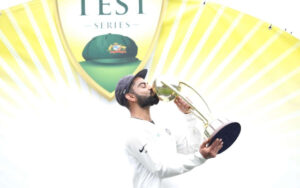
Cricket, it wouldn’t be wrong to suggest, was and is the true national game in both India and Australia. This is precisely because it could be played against the English as part of the great imperial project. Hockey in India or Aussie Rules in Australia could not, and hence their legacies, like their origins, remain very curious in the sporting hierarchies of the two countries.
More recently, however, the India-Australia rivalry has gathered steam with Australia gradually becoming the new Pakistan as far as Indian cricket fans are concerned. This works well for us in India. With bilateral series against Pakistan a thing of the past as a result of the political chaos across the border, Indian fans, with their great appetite for spectacles, needed a new great adversary. Australia fit the bill perfectly.
Incidents like Monkeygate in 2008 triggered it further and Australian aggression on the field became grist for the hate mill. Individual battles like the one between Steve Smith and Virat Kohli for the mantle of the world’s best batsman have helped churn the sentiment, and on the eve of the start of the Border-Gavaskar Trophy, it is certain that we are about to witness more than a high-powered cricket series.
It all started in 1947-48, when the Indians had the fortune, or rather misfortune, of facing Sir Donald Bradman when a just-independent India toured Down Under. This was the first official India-Australia cricket series, an extraordinary tour of many firsts. It was the first occasion that India played official Test cricket against any side other than England and it was the only occasion when they had the opportunity of playing Bradman.
For the record, India lost the series 0-4 and this rout, it can be asserted, was almost solely orchestrated by Bradman. Though 39, he was still at his best and his scores – 185 in the first Test, 132 and 127 not out in the third, 201 in the fourth and 57 retired hurt in the fifth – bear testimony to his contemptuous dominance of the Indian attack.
For the Latest Sports News: Click Here

From the very start for both Australia and India, cricket has been a vehicle from which to express national achievement and ambition. Even when bilateral relations were at a low ebb (1950-70), cricket was seen as the natural cultural bridge between the two nations. Yet, this was a rather uneasy phase of cricket relations with Australian teams unwillingly to go to the subcontinent and Indian teams barely supported Down Under because of their poor playing ability. Even when personal friendships flourished between players like Bradman and Vijay Hazare, and individual players earned popularity – like Bishan Singh Bedi in Australia and Richie Benaud in India – they did little to promote deeper social and political exchanges.
Matters changed substantially under Prime Minister Gough Whitlam (1972-75), whose enlightened attitude towards India helped create an Australia capable of more independent foreign policy formation. This was helped by the enthusiastic response to Whitlam by Prime Minister Indira Gandhi. Improved political relations impacted cricket as well, allowing the more structured economy (Australia) to harness the economic worth of cricket in India.
This transformation has only been cemented since. For example, India’s tour of Australia in 2003-4 assumed tremendous significance back home, interest stimulated by the spectacular individual performances from the Indians in the Test series. The growing significance of Indo-Australian cricket had a perceptible impact on tourism Down Under as well. In the wake of India’s series in 2004, no less than 3000 Indians arrived in Australia to cheer their team, a first for Indian sport. With live television bringing the action to the comfort of Indian living rooms, Australia was suddenly an attractive tourist destination as well as a trading partner.
In 2007-8, in the wake of the Monkeygate controversy, these figures witnessed a sharp rise. In fact, the 2011-12 series and the one that followed in 2014-15 witnessed over 10,000 Indians travelling to Australia to watch the cricket. These figures increased in 2018-19, the first time India won a series on Australian soil in 71 years.
In fact, the Border-Gavaskar Trophy, it could be argued, is now one of modern cricket’s signature rivalries, and jostles with the Ashes for interest generated across the world. With another chapter just about to start, we can expect some high-quality cricket in the next two months, adding more chapters to an already rich history.




